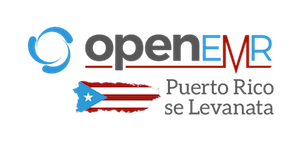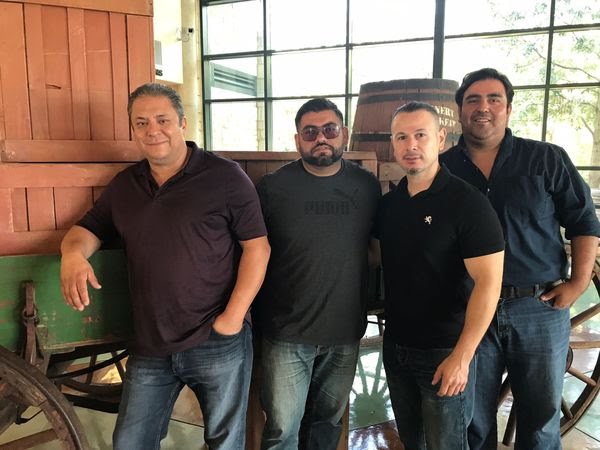disaster response
See the following -
OpenEMR Stands Up To Hurricane Maria's Fury in Puerto Rico
 Throughout both Hurricane Maria's initial impact and the rebuilding efforts, Puerto Rico has suffered tremendous infrastructure damage leaving the majority of the islands some 3.4 million people without power, water, communications, and internet access. Despite these challenges, OpenEMR would prove to be vital at multiple healthcare facilities as the island begins the process of rebuilding. During and immediately following the hurricane's devastating wind and rain, the following healthcare providers noted OpenEMR as an essential tool in receiving and assisting a large volume of patients...
Throughout both Hurricane Maria's initial impact and the rebuilding efforts, Puerto Rico has suffered tremendous infrastructure damage leaving the majority of the islands some 3.4 million people without power, water, communications, and internet access. Despite these challenges, OpenEMR would prove to be vital at multiple healthcare facilities as the island begins the process of rebuilding. During and immediately following the hurricane's devastating wind and rain, the following healthcare providers noted OpenEMR as an essential tool in receiving and assisting a large volume of patients...
- Login to post comments
Opinion: See the Most Vulnerable -- See the Human Landscape
The world is currently experiencing the worst humanitarian crises since World War II. Over 20 million people are at risk of starvation and famine across Yemen, South Sudan, Nigeria and Somalia. Now entering its seventh year of conflict, the Syrian civil war rages on without an end in sight, representing the largest portion of refugees and internally displaced people globally. To be effective in helping these IDPs, relief organizations must have easy access to relevant and accurate locational data...
- Login to post comments
Redesigning International Disaster Reponse, Part 4: Current Innovation
Founded in 2008, Ushahidi was created as a website platform to track events in the wake of Kenya's controversial presidential election by geolocating first-hand accounts of violence in Google Maps. Ushahidi made headlines after it was implemented during the Haiti Earthquakes to track emergencies, public health problems and other hazards. The platform represents a shift towards responders relying on on-the-ground, up-to-the-minute, crowd-sourced information.
- Login to post comments
Rock Around The Resilience Wheel - Continuity of Operations Through Disruptive Change
 As 2020 comes to a close we are still faced with myriad issues pertaining to public health, elections, economic duress and recovery, unemployment, and living under persistent, pendular change. Resilience has become a popular buzzword to get through these times but is utilized to mean very different things to people looking through very different lenses. Diverse definitions are great but at some point, at some higher and comprehensive perspective, a bow must be put around a common resilience baseline. In layman’s terms, resilience is getting through disruptions and change with some foresight and planning. Resilience matters regardless of the lens you are viewing it through. Covenant Park has coined several catchphrases over our several decades of resilience, risk, continuity, emergency management, security, and national and international planning and execution. Some of those phrases include:
As 2020 comes to a close we are still faced with myriad issues pertaining to public health, elections, economic duress and recovery, unemployment, and living under persistent, pendular change. Resilience has become a popular buzzword to get through these times but is utilized to mean very different things to people looking through very different lenses. Diverse definitions are great but at some point, at some higher and comprehensive perspective, a bow must be put around a common resilience baseline. In layman’s terms, resilience is getting through disruptions and change with some foresight and planning. Resilience matters regardless of the lens you are viewing it through. Covenant Park has coined several catchphrases over our several decades of resilience, risk, continuity, emergency management, security, and national and international planning and execution. Some of those phrases include:
- Login to post comments
Stephen F. Austin Community Health Center Thanks Clinica Sierra Vista for Loan of Mobile Medical Unit to Care for Victims of Hurricane Harvey
 Stephen F. Austin Community Health Center (SFACHC) extends many thanks to Clinica Sierra Vista and its excellent staff for the assistance and kindness our friends to the west bestowed on SFACHC and the residents of Brazoria County in the aftermath of Hurricane Harvey. The generous loan of the Bakersfield, California community health center’s Mobile Unit is making it possible for SFACHC to provide essential primary health care, including tetanus shots, to evacuees staying in shelters established after Hurricane Harvey’s record rainfall flooded homes in Brazoria County and neighboring Galveston County.
Stephen F. Austin Community Health Center (SFACHC) extends many thanks to Clinica Sierra Vista and its excellent staff for the assistance and kindness our friends to the west bestowed on SFACHC and the residents of Brazoria County in the aftermath of Hurricane Harvey. The generous loan of the Bakersfield, California community health center’s Mobile Unit is making it possible for SFACHC to provide essential primary health care, including tetanus shots, to evacuees staying in shelters established after Hurricane Harvey’s record rainfall flooded homes in Brazoria County and neighboring Galveston County.
- Login to post comments
The Government’s Hurricane Sandy Pages Play By Play
With its satellites, scanners and links to local officials, the federal government is often the best source for trusted information during a hurricane, tornado or other natural disaster. Read More »
- Login to post comments
The State Of HIE As 2012 Comes To A Close
Although medical professionals may have been using the phrase "health information exchange" for centuries, the health information sharing organizational arrangement used today was first mentioned in the popular media by the Canadian Press in 1977, according to Google's archives, when Canadian health officials agreed to set up an inter-provincial HIE for studying coronary bypass surgeries and occupational health trends. Read More »
- Login to post comments
The Supercharged Technology Behind The Nemo Blizzard Emergency Alert
With Winter Storm Nemo bearing down on the Northeast, many Americans are bracing for a blast of snow — but some Thursday got a blast of a different kind instead. Thousands of Verizon users reported getting an emergency alert about the coming blizzard on their cell phones that looked a bit like this... Read More »
- Login to post comments
The Thin Line Group
 ThinLine was founded to assist federal, state, and local government agencies, commercial and private sector organizations, with continuity planning, disaster prevention, and disaster response. ThinLine provides consulting services and material solutions that address evolving man-made threats such as cyber warfare and terrorist threats. In addition, the Thin Line also addresses the dynamic environmental conditions that follow catastrophic natural disasters such as failing infrastructure. The Thin Line Group supports individuals and organizations that need realistic and sustainable resilience solutions to protect life, property, information, and functions.
ThinLine was founded to assist federal, state, and local government agencies, commercial and private sector organizations, with continuity planning, disaster prevention, and disaster response. ThinLine provides consulting services and material solutions that address evolving man-made threats such as cyber warfare and terrorist threats. In addition, the Thin Line also addresses the dynamic environmental conditions that follow catastrophic natural disasters such as failing infrastructure. The Thin Line Group supports individuals and organizations that need realistic and sustainable resilience solutions to protect life, property, information, and functions.
- Login to post comments
This Is What Californians Really Needed During the Fires
Before daybreak on Monday, at 6 a.m., my phone was alight with texts and phone calls -- hours after some had been chased from their homes by flames. I woke up bleary-eyed and answered the latest call. "It's gone," my cousin said, her voice drained by shock, "It's all gone." As a reporter, I've chased more tragedies than I can count. Mass shootings, murders, suicides, fallen trees, car accidents — you name it. I drove into them, ran into them, knocked on their doors, called them on the phone. But this week, the tragedy came to me. By that morning, Santa Rosa was in flames, along with other parts of Sonoma, Mendocino, Napa and Solano counties. By late Monday morning, hordes of people in packed cars were headed north, many with no certainty where they were going...
- Login to post comments
Upgrading the PULSE Emergency Response Tool to a Community Edition
 Seven years ago the Office of the National Coordinator for Health Information Technology (ONC) began work on the Patient Unified Lookup System for Emergencies (PULSE). PULSE is an effort to create national resilience by improving first responder access to patient electronic health information they need to provide services and ensure public health during disasters, including public health emergencies. Recently, ONC launched a new, code-only technical solution called PULSE-Community Edition (PULSE Community) that builds on the original PULSE code. PULSE Community enables first responders and other response personnel (e.g., epidemiologists, emergency medical services, and health care volunteers) to securely access vital health information they need during emergencies and disasters from connected health care organizations.
Seven years ago the Office of the National Coordinator for Health Information Technology (ONC) began work on the Patient Unified Lookup System for Emergencies (PULSE). PULSE is an effort to create national resilience by improving first responder access to patient electronic health information they need to provide services and ensure public health during disasters, including public health emergencies. Recently, ONC launched a new, code-only technical solution called PULSE-Community Edition (PULSE Community) that builds on the original PULSE code. PULSE Community enables first responders and other response personnel (e.g., epidemiologists, emergency medical services, and health care volunteers) to securely access vital health information they need during emergencies and disasters from connected health care organizations.
- Login to post comments
Ushahidi - An Open Source Disaster & Crisis Management Mapping Tool
 Ushahidi is a non-profit technology company specializing in developing open source software (OSS) for information collection, visualization, communications, and mapping. The core platform is built on the premise that gathering crisis information from the general public provides new insights into events happening in near real-time. It can also be used to help organizations marshal efforts to assist areas facing manmade or natural disasters that are not well covered in the mainstream media.
Ushahidi is a non-profit technology company specializing in developing open source software (OSS) for information collection, visualization, communications, and mapping. The core platform is built on the premise that gathering crisis information from the general public provides new insights into events happening in near real-time. It can also be used to help organizations marshal efforts to assist areas facing manmade or natural disasters that are not well covered in the mainstream media.
- Login to post comments
Ushahidi And Designing For Data: Next Steps
There is no doubt in my mind that Ushahidi and Crowdmap are successes in their own right. The platforms fills huge information gap in crisis operations and people know it. But with any success comes the expectation that you continue to evolve the solution to meet the growing demands of the user base. [...] Read More »
- Login to post comments
Ushahidi – Revolutionizing Disaster Relief
With tools like Ushahidi, humanitarian work can now operate much differently than it has in the past. In the past, humanitarian work was limited in part by the small number of foreign journalists who were able to get to a disaster location and report on events there.
- Login to post comments
Using OpenStreetMap To Respond To Disasters Before They Happen
Kate Chapman, executive director of the Humanitarian OpenStreetMap Team, gave Tuesday's keynote at Linux.conf.au about preparing and responding for disasters with the help of communities. Read More »
- Login to post comments